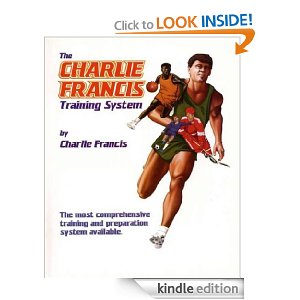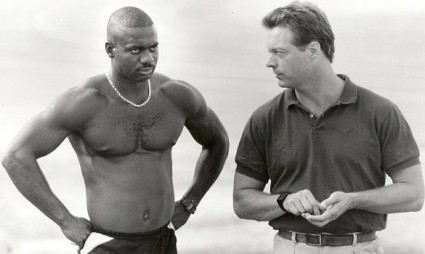Charlie Francis reached the peak of his coaching career when his athlete won a gold medal in the 100 meters at the 1988 Summer Olympics. THE single most highly regarded achievement in the world of sports among physical preparation coaches.
Why?
Cause everybody runs…and the guy who wins the 100 at the Olympics is,
THE FASTEST MAN IN THE WORLD
and that sh@t matters.
Problem was that athlete was Ben Johnson…..yeah, THAT, Ben Johnson.
The one who got disqualified for steroid use.
So now you’re all like, “How is he so great? His athletes used steroids and steroids are evil tools of cheaters. Righteous, virgin athletes like Lance Armstrong, Arnold Schwarzenegger, Marion Jones, Rafael Palmeiro, Alex Rodriguez, Roger Clemons, Mark McGwire and Sammy Sosa that guy that ran a 11.0 in high school and won the county championship didn’t need them. Charlie Francis is an evil man and suxxx….BAD“
Charlie was in-fact great because EVERYONE in truly ELITE, world-class, sport is on some type of performance enhancer and that’s a fact jack (or have you just not paid attention for the last 5 years) and he got the best results from his athletes.
Plus, there is waaaaay more to the Ben Johnson story, how this went down and the subsequent fallout than most people realize.
If you’re interested in actually knowing what happened read Speed Trap and watch 9.79 and Bigger, Stronger, Faster. You’ll get the feeling there were some dirty dealings going on and maybe, just maybe…
Ben Johnson and Charlie Francis got screwed.
So now that we’re not going to worry about the drug use anymore.
Why is this book so damn good.
Basically it’s,
How to Create A World Class Training Program for Dummies
The book is written in a question and answer format and it reads like a conversation.
Someone who has virtually no knowledge of physiology and the training process could read this book and come away (2-3 hours later) and have a VERY good grasp on what constitutes an effective program.
It outlines the importance of a knowledgeable, attentive, caring and intuitive coach in the development of an elite athlete.
This book is in no way about sets, reps and weights but instead about principles and guidelines.
The Charlie Francis Training System is about the management of the athlete as a constantly adapting biological organism to allow for the highest possible achievement when it counts.
“The ultimate goal of the coach-athlete dyad is to bring the athlete to peak performance and to bring them to that state predictably in terms of place and time”
“The task faced by a coach is to comprehend the interplay between training factors and based on that understanding, prescribe what your athletes need- when they need it”
This is a very different approach than that of the typical “piece of meat- do what the spreadsheet says” style of program “management” that is often employed by “coaches” today.
Too often athletes who are not fully recovered yet are training or competing above the level they are capable of at that moment simply because the program the coach has laid out says such and such training or competing should happen now…this results in nothing but injury, overtraining and failing performances.
And we wonder why there are so many non-contact soft tissue injuries in sports today.
“A basic principle underlying all training is to bring only a fully regenerated athlete to each training element. The element is then performed with the highest quality possible”
Much of Charlie’s success came from understanding the concept of individualization. Realizing that athletes are individual people, they don’t all require, nor will they receive the same outcomes from the same programming.
Therefore cookie-cutter programming is less-than-optimal and will not result in the best results possible and “results are all that matters”:
“There is no cookbook of coaching techniques which will apply equally well to all athletes”
“You have to be prepared to change the program at any time, based on how the athlete feels and what you see”
“Not all athletes do all exercises”
” My job is to listen to what the athlete or the athletes body is saying”
Much of the book deals with management of the CNS and regeneration delving into how and when to program heavy weights, speed work, massage, chiropractic and even EMS (electro-magnetic stimulation).
“adjust this volume in accordance with the apparent energy-status of the athletes on arriving at the workout as it is revealed during warm-up, and as it changes during the actual performance of CNS related work. You stop when a personal best (PB) or a near PB is performed or when intensity or technique visibly degrades”
“At the highest levels of sport there is a quantum increase in CNS output for every increment of improvement …a 95% effort might require a recovery period of only 48 hours while a 100% effort might require up to 10 days”
“On a given day there is only so much CNS energy to expend….when it’s drained, it’s drained”
“CNS fatigues first and causes the body to shut down before the peripheral musculature is totally exhausted”
“Persistent tightness is a sign of poor regeneration and/ or poor management of regeneration in the training process”
Charlie’s stated goal for the book:
“teach coaches how not to trash an athlete. There are so many coaches who in their quest to get results trash their athletes This is wrong! Coaches should not be learning their profession by hurting athletes.”
Charlie Francis clearly understood how to develop an athlete from an amateur into a world champion, and for a time he did it better than anyone else.
He truly understood,
More is NOT better, better is better.
Performing high quality work will always trump simply doing a lot of work when dealing with athletes.
You WILL NOT get as much, high quality, easily digestible, information from another book on training.
If you train for ANYTHING even something as simple as 5K’s this book would be well worth the $10 it costs on the Kindle.





[…] As a former athlete it meant I was losing my athleticism, 27 really sucked cause that’s the age Charlie Francis used as a cutoff for his trainee’s. […]